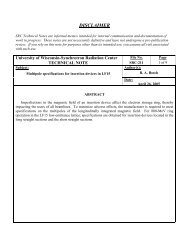'Pancake' at the Cathode for Production of 'Blowout' - Synchrotron ...
'Pancake' at the Cathode for Production of 'Blowout' - Synchrotron ...
'Pancake' at the Cathode for Production of 'Blowout' - Synchrotron ...
You also want an ePaper? Increase the reach of your titles
YUMPU automatically turns print PDFs into web optimized ePapers that Google loves.
DISCLAIMER<br />
SRC Technical Notes are in<strong>for</strong>mal memos intended <strong>for</strong> internal communic<strong>at</strong>ion and document<strong>at</strong>ion <strong>of</strong><br />
work in progress. These notes are not necessarily definitive and have not undergone a pre-public<strong>at</strong>ion<br />
review. If you rely on this note <strong>for</strong> purposes o<strong>the</strong>r than its intended use, you assume all risk associ<strong>at</strong>ed<br />
with such use.<br />
University <strong>of</strong> Wisconsin-<strong>Synchrotron</strong> Radi<strong>at</strong>ion Center<br />
TECHNICAL NOTE<br />
Subject:<br />
Modeling <strong>of</strong> <strong>the</strong> Initial Charge ‘Pancake’ <strong>at</strong> <strong>the</strong> C<strong>at</strong>hode <strong>for</strong><br />
<strong>Production</strong> <strong>of</strong> ‘Blowout’ Mode Bunches<br />
File No.<br />
220<br />
Author(s):<br />
Legg, R.<br />
D<strong>at</strong>e:<br />
28July2007<br />
In order to model an electron gun which produces an ellipsoidal bunch using <strong>the</strong> “blow out” mode, an analogue <strong>of</strong> <strong>the</strong> initial<br />
“pancake” <strong>of</strong> charge produced <strong>at</strong> <strong>the</strong> c<strong>at</strong>hode by a corresponding drive laser pulse must be simul<strong>at</strong>ed. This initial “pancake” <strong>of</strong><br />
charge must have <strong>the</strong> correct “hemispherical” transverse density pr<strong>of</strong>ile [1], Fig 1<br />
Page<br />
3<br />
Figure 1<br />
The particles in this distribution should also model <strong>the</strong> ‘<strong>the</strong>rmal’ emittance, associ<strong>at</strong>ed with <strong>the</strong> laser spot size and <strong>the</strong> particular<br />
c<strong>at</strong>hode m<strong>at</strong>erial. I’ve been using Cs2Te as a c<strong>at</strong>hode m<strong>at</strong>erial because <strong>of</strong> its rel<strong>at</strong>ive high QE when compared to metal<br />
c<strong>at</strong>hodes and prompt response when compared to Cs:GaAs. Cs2Te has a measured, projected, ‘<strong>the</strong>rmal’ emittance <strong>of</strong> roughly 1<br />
mm-mrad/mm RMS <strong>of</strong> laser spot size [2]. ASTRA [3] has a module called Gener<strong>at</strong>or which allows <strong>the</strong> user to choose a<br />
uni<strong>for</strong>m ellipsoidal distribution which reproduces <strong>the</strong> hemispherical transverse distribution. Using this built-in distribution in<br />
Gener<strong>at</strong>or, <strong>the</strong> initial charge ‘pancake’ can be defined transversely using <strong>the</strong> built-in uni<strong>for</strong>m ellipsoidal distribution, <strong>the</strong> initial<br />
RMS radius <strong>for</strong> <strong>the</strong> charge pancake, and <strong>the</strong> transverse emittance which is defined by th<strong>at</strong> radius and <strong>the</strong> c<strong>at</strong>hode m<strong>at</strong>erial.<br />
Longitudinally <strong>the</strong> model is even simpler. According to [4], so long as <strong>the</strong> laser pulse is short enough compared to <strong>the</strong> length<br />
<strong>of</strong> <strong>the</strong> infl<strong>at</strong>ed bunch, ~0.01 in this case, any particle distribution acts like an impulse function and will evolve to <strong>the</strong> desired<br />
ellipsoid with constant charge density under <strong>the</strong> effects <strong>of</strong> space charge <strong>for</strong>ces. In my standard simul<strong>at</strong>ions, <strong>the</strong> longitudinal<br />
distribution is defined by <strong>the</strong> ‘uni<strong>for</strong>m ellipsoid’ distribution and <strong>the</strong> RMS emission time is set by a variable to 30 fsec. The
longitudinal kinetic energy pr<strong>of</strong>ile used models <strong>the</strong> electron energy distribution from a Cs2Te c<strong>at</strong>hode; ~0.6eV depending on<br />
<strong>the</strong> laser wavelength. The distribution should look like an almost mono-energetic spike when viewed in longitudinal pr<strong>of</strong>ile.<br />
The Gener<strong>at</strong>or input file looks like:<br />
&INPUT<br />
FNAME = 'ellipsegun.ini'<br />
Add=.F.<br />
N_add=1<br />
IPart=10000<br />
Species='electrons'<br />
Probe=.True.<br />
Noise_reduc=.T.<br />
C<strong>at</strong>hode=.T.<br />
Q_total=0.20E0<br />
Ref_zpos=0.0E0<br />
Ref_clock=0.0E-5<br />
Ref_Ekin=0.0<br />
Dist_z='uni<strong>for</strong>m ellipsoid',<br />
sig_clock=1.5E-5, sig_x=0.8E0, sig_y=0.8E0<br />
Nemit_x=0.74E0, Nemit_y=0.74E0<br />
/<br />
This produces a distribution file with columns <strong>of</strong> numbers representing x, y, z, px, py, pz, clock, charge, particle index and a<br />
particle st<strong>at</strong>us flag. For more details, see <strong>the</strong> document<strong>at</strong>ion <strong>at</strong> http://www.desy.de/~mpyflo/Astra_dokument<strong>at</strong>ion/. As a<br />
practical measure, ASTRA supplies ano<strong>the</strong>r utility called ‘Postpro’ which can display <strong>the</strong> distribution graphically. Because <strong>the</strong><br />
initial distribution was gener<strong>at</strong>ed in a temporal r<strong>at</strong>her longitudinal coordin<strong>at</strong>e, <strong>the</strong> initial distribution will not have a length,<br />
only an emission time. In using Postpro with an .ini file, only one <strong>of</strong> <strong>the</strong> two longitudinal displays, t or z, will have valid d<strong>at</strong>a<br />
in it, but this is still a very useful tool in order to check <strong>the</strong> initial c<strong>at</strong>hode spot size and energy distribution. A typical<br />
distribution is shown in Figure 2. Note th<strong>at</strong> <strong>the</strong> projection <strong>of</strong> <strong>the</strong> plot <strong>of</strong> x or y versus particle density will be a parabola <strong>for</strong> a<br />
hemispherical distribution, since <strong>the</strong> projection includes <strong>the</strong> density vari<strong>at</strong>ion due to <strong>the</strong> bunch shape as well as <strong>the</strong> particle<br />
distribution.<br />
Figure 2<br />
The one problem with using this method to gener<strong>at</strong>e an initial distribution is th<strong>at</strong> <strong>the</strong> longitudinal distribution pr<strong>of</strong>ile cannot be<br />
controlled; it’s always ellipsoidal. If a non- ellipsoidal distribution is desired, <strong>the</strong>n <strong>the</strong>re is a second approach to gener<strong>at</strong>ing an<br />
initial distribution with a hemispherical transverse distribution. The approach uses Gener<strong>at</strong>or’s ability to add multiple<br />
distributions toge<strong>the</strong>r. The transverse distribution is divided into a set <strong>of</strong> charge ‘pancakes’ <strong>of</strong> different diameters with uni<strong>for</strong>m<br />
charge distribution. The diameters <strong>of</strong> <strong>the</strong> ‘pancakes’ are chosen such th<strong>at</strong> when added toge<strong>the</strong>r – ‘stacked’ – <strong>the</strong> correct<br />
transverse distribution is produced. Since each charge ‘pancake’ is specified individually, any longitudinal distribution pr<strong>of</strong>ile<br />
can be selected. The particle density distribution produced will have edges where each ‘pancake’ is added to <strong>the</strong> ‘stack’, but if<br />
a sufficient number <strong>of</strong> individual distributions are added toge<strong>the</strong>r initially, <strong>the</strong> edges become small overall much like a<br />
Newton’s approxim<strong>at</strong>ion <strong>of</strong> a function going toward <strong>the</strong> limit.<br />
To produce ‘pancakes’ which have <strong>the</strong> correct amount <strong>of</strong> charge <strong>for</strong> a given diameter, it is necessary to solve <strong>the</strong> integral <strong>for</strong> a<br />
sphere in x and <strong>the</strong>n use <strong>the</strong> <strong>for</strong>mula below to calcul<strong>at</strong>e <strong>the</strong> volume in a slice whose thickness is a fraction <strong>of</strong> <strong>the</strong> radius <strong>of</strong> <strong>the</strong><br />
sphere and <strong>the</strong>n normalizing to <strong>the</strong> total bunch charge, . This method lends itself to spreadsheet solutions, and <strong>for</strong> convenience
I use 10 slices per hemisphere to gener<strong>at</strong>e my distributions. The transverse distribution, with projections, <strong>for</strong> this initial<br />
distribution is shown in Figure 3. For most runs <strong>the</strong> simpler uni<strong>for</strong>m ellipsoidal distribution is used <strong>for</strong> its smoo<strong>the</strong>r, more<br />
uni<strong>for</strong>m distribution.<br />
Charge in slice =<br />
3 2<br />
⎡ 2 x ⎤<br />
π ⎢r<br />
x − × Q<br />
3<br />
⎥<br />
⎣ ⎦<br />
x<br />
x<br />
1<br />
Total<br />
2πr<br />
3<br />
3<br />
Figure 3<br />
DETAILS: In order to model non-uni<strong>for</strong>mities in <strong>the</strong> photoc<strong>at</strong>hode’s emission, it is possible to add additional bunches cre<strong>at</strong>ed<br />
using gener<strong>at</strong>or to <strong>the</strong> “perfect” initial distribution. These additional distributions can be made using smaller, <strong>of</strong>f-axis spots<br />
which simul<strong>at</strong>e emission hot spots on <strong>the</strong> c<strong>at</strong>hode. This allows <strong>the</strong> user to cre<strong>at</strong>e emission sites on <strong>the</strong> c<strong>at</strong>hode which are<br />
transversely <strong>of</strong>f axis from <strong>the</strong> bulk <strong>of</strong> <strong>the</strong> emitted beam or th<strong>at</strong> have significantly different emittance properties from <strong>the</strong> bulk <strong>of</strong><br />
<strong>the</strong> beam, <strong>for</strong> example a field emitter on a photoc<strong>at</strong>hode. An example distribution is shown in Figure 4. By running<br />
simul<strong>at</strong>ions using initial distributions with imperfections, <strong>the</strong>ir effect on <strong>the</strong> final bunch pr<strong>of</strong>iles, emittance and energy<br />
distributions can be estim<strong>at</strong>ed.<br />
Figure 4<br />
Bibliography:<br />
1. O.J. Luiten, S.B.van der Geer, et al. Phys Rev Lett. 93, 094802 (2004)<br />
2. V. Miltchev, Investig<strong>at</strong>ions on <strong>the</strong> transverse phase space <strong>at</strong> a photo injector <strong>for</strong> minimized emittance, Dissert<strong>at</strong>ion,<br />
University <strong>of</strong> Berlin, Feb 3, 2006<br />
3. K. Flottmann, http://www.desy.de/~mpyflo/<br />
4. C. Limborg-Deprey, P. Bolton, NIM-A, 557 (2006) 106-116
















